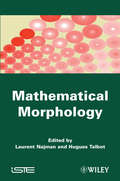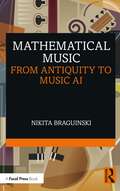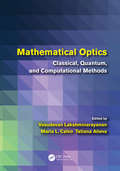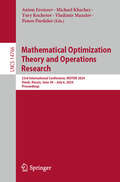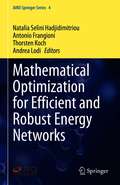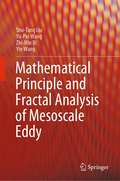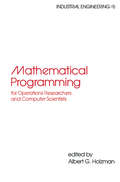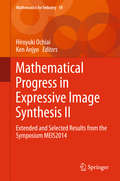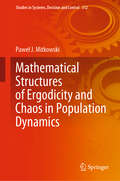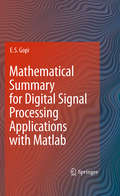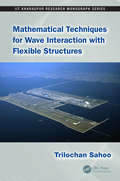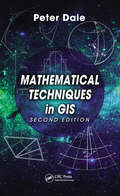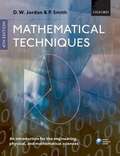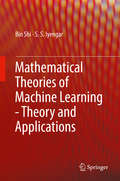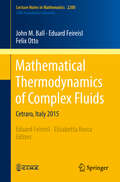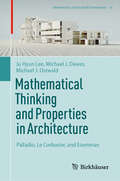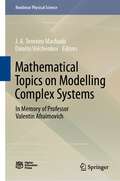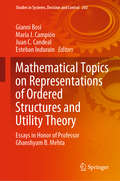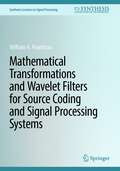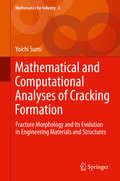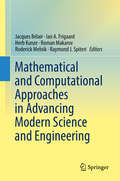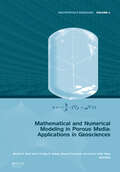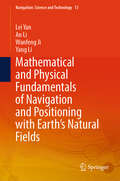- Table View
- List View
Mathematical Morphology: From Theory to Applications (Wiley-iste Ser. #Vol. 30)
by Hugues Talbot Laurent NajmanMathematical Morphology allows for the analysis and processing of geometrical structures using techniques based on the fields of set theory, lattice theory, topology, and random functions. It is the basis of morphological image processing, and finds applications in fields including digital image processing (DSP), as well as areas for graphs, surface meshes, solids, and other spatial structures. This book presents an up-to-date treatment of mathematical morphology, based on the three pillars that made it an important field of theoretical work and practical application: a solid theoretical foundation, a large body of applications and an efficient implementation. The book is divided into five parts and includes 20 chapters. The five parts are structured as follows: Part I sets out the fundamental aspects of the discipline, starting with a general introduction, followed by two more theory-focused chapters, one addressing its mathematical structure and including an updated formalism, which is the result of several decades of work. Part II extends this formalism to some non-deterministic aspects of the theory, in particular detailing links with other disciplines such as stereology, geostatistics and fuzzy logic. Part III addresses the theory of morphological filtering and segmentation, featuring modern connected approaches, from both theoretical and practical aspects. Part IV features practical aspects of mathematical morphology, in particular how to deal with color and multivariate data, links to discrete geometry and topology, and some algorithmic aspects; without which applications would be impossible. Part V showcases all the previously noted fields of work through a sample of interesting, representative and varied applications.
Mathematical Music: From Antiquity to Music AI
by Nikita BraguinskiMathematical Music offers a concise and easily accessible history of how mathematics was used to create music. The story presented in this short, engaging volume ranges from ratios in antiquity to random combinations in the 17th century, 20th-century statistics, and contemporary artificial intelligence. This book provides a fascinating panorama of the gradual mechanization of thought processes involved in the creation of music. How did Baroque authors envision a composition system based on combinatorics? What was it like to create musical algorithms at the beginning of the 20th century, before the computer became a reality? And how does this all explain today’s use of artificial intelligence and machine learning in music? In addition to discussing the history and the present state of mathematical music, Braguinski also takes a look at what possibilities the near future of music AI might hold for listeners, musicians, and the society. Grounded in research findings from musicology and the history of technology, and written for the non-specialist general audience, this book helps both student and professional readers to make sense of today’s music AI by situating it in a continuous historical context.
Mathematical Optics: Classical, Quantum, and Computational Methods
by Vasudevan Lakshminarayanan Maria L. Calvo Tatiana AlievaGoing beyond standard introductory texts, Mathematical Optics: Classical, Quantum, and Computational Methods brings together many new mathematical techniques from optical science and engineering research. Profusely illustrated, the book makes the material accessible to students and newcomers to the field. Divided into six parts, the text presents state-of-the-art mathematical methods and applications in classical optics, quantum optics, and image processing. Part I describes the use of phase space concepts to characterize optical beams and the application of dynamic programming in optical waveguides. Part II explores solutions to paraxial, linear, and nonlinear wave equations. Part III discusses cutting-edge areas in transformation optics (such as invisibility cloaks) and computational plasmonics. Part IV uses Lorentz groups, dihedral group symmetry, Lie algebras, and Liouville space to analyze problems in polarization, ray optics, visual optics, and quantum optics. Part V examines the role of coherence functions in modern laser physics and explains how to apply quantum memory channel models in quantum computers. Part VI introduces super-resolution imaging and differential geometric methods in image processing. As numerical/symbolic computation is an important tool for solving numerous real-life problems in optical science, many chapters include Mathematica® code in their appendices. The software codes and notebooks as well as color versions of the book’s figures are available at www.crcpress.com.
Mathematical Optimization Theory and Operations Research: 23rd International Conference, MOTOR 2024, Omsk, Russia, June 30–July 6, 2024, Proceedings (Lecture Notes in Computer Science #14766)
by Panos Pardalos Yury Kochetov Michael Khachay Anton Eremeev Vladimir MazalovThis book constitutes the refereed proceedings of the 23rd International Conference on Mathematical Optimization Theory and Operations Research, MOTOR 2024, held in Omsk, Russia, during June 30 - July 6, 2024. The 30 full papers included in this book were carefully reviewed and selected from 79 submissions. This book also contains two invited talk. They were organized in topical sections as follows: mathematical programming; combinatorial optimization; game theory; and operations research.
Mathematical Optimization for Efficient and Robust Energy Networks (AIRO Springer Series #4)
by Thorsten Koch Andrea Lodi Natalia Selini Hadjidimitriou Antonio FrangioniThis book presents a collection of energy production and distribution problems identified by the members of the COST Action TD1207 "Mathematical Optimization in the Decision Support Systems for Efficient and Robust Energy Networks". The aim of the COST Action was to coordinate the efforts of the experts in different fields, from academia and industry, in developing innovative tools for quantitative decision making, and apply them to the efficient and robust design and management of energy networks. The work covers three main goals:• to be a nimble while comprehensive resource of several real life business problems with a categorized set of pointers to many relevant prescriptive problems for energy systems;• to offer a balanced mix of scientific and industrial views;• to evolve over time in a flexible and dynamic way giving, from time to time, a more scientific or industrial - or even political in a broad sense - weighed perspective.It is addressed to researchers and professionals working in the field.
Mathematical Physics: Applications and Problems
by V. BalakrishnanThis textbook is aimed at advanced undergraduate and graduate students interested in learning the fundamental mathematical concepts and tools widely used in different areas of physics. The author draws on a vast teaching experience, and presents a comprehensive and self-contained text which explains how mathematics intertwines with and forms an integral part of physics in numerous instances. Rather than emphasizing rigorous proofs of theorems, specific examples and physical applications (such as fluid dynamics, electromagnetism, quantum mechanics, etc.) are invoked to illustrate and elaborate upon the relevant mathematical techniques. The early chapters of the book introduce different types of functions, vectors and tensors, vector calculus, and matrices. In the subsequent chapters, more advanced topics like linear spaces, operator algebras, special functions, probability distributions, stochastic processes, analytic functions, Fourier series and integrals, Laplace transforms, Green's functions and integral equations are discussed. The book also features about 400 exercises and solved problems interspersed throughout the text at appropriate junctures, to facilitate the logical flow and to test the key concepts. Overall this book will be a valuable resource for a wide spectrum of students and instructors of mathematical physics.
Mathematical Principle and Fractal Analysis of Mesoscale Eddy
by Shu-Tang Liu Yin Wang Yu-Pin Wang Zhi-Min BiThis book focuses on universal nonlinear dynamics model of mesoscale eddies. The results of this book are not only the direct-type applications of pure mathematical limit cycle theory and fractal theory in practice but also the classic combination of nonlinear dynamic systems in mathematics and the physical oceanography. The universal model and experimental verification not only verify the relevant results that are obtained by Euler's form but also, more importantly, are consistent with observational numerical statistics. Due to the universality of the model, the consequences of the system are richer and more complete. The comprehensive and systematic mathematical modeling of mesoscale eddies is one of the major features of the book, which is particularly suited for readers who are interested to learn fractal analysis and prediction in physical oceanography. The book benefits researchers, engineers, and graduate students in the fields of mesoscale eddies, fractal, chaos, and other applications, etc.
Mathematical Principles of Remote Sensing: Making Inferences from Noisy Data
by Andrew S MilmanThis book is an informative reference, or working textbook, on the mathematics, and general physical and chemical processes behind remote sensor measurements.
Mathematical Programming for Operations Researchers and Computer Scientists
by Albert G. HolzmanThis book covers the fundamentals of linear programming, extension of linear programming to discrete optimization methods, multi-objective functions, quadratic programming, geometric programming, and classical calculus methods for solving nonlinear programming problems.
Mathematical Progress in Expressive Image Synthesis II
by Hiroyuki Ochiai Ken AnjyoThe material included in this book provides selected presentations given at the international symposium MEIS2014. The book aims to provide a unique venue where various issues in computer graphics (CG) application fields are discussed by mathematicians as well as CG researchers and practitioners. The target audience is not limited to researchers in academia but also those in industries with a strong interest in digital media creation, scientific visualization and visual engineering.
Mathematical Structures of Ergodicity and Chaos in Population Dynamics (Studies in Systems, Decision and Control #312)
by Paweł J. MitkowskiThis book concerns issues related to biomathematics, medicine, or cybernetics as practiced by engineers. Considered population dynamics models are still in the interest of researchers, and even this interest is increasing, especially now in the time of SARS-CoV-2 coronavirus pandemic, when models are intensively studied in order to help predict its behaviour within human population. The structures of population dynamics models and practical methods of finding their solutions are discussed. Finally, the hypothesis of the existence of non-trivial ergodic properties of the model of erythropoietic response dynamics formulated by A. Lasota in the form of delay differential equation with unimodal feedback is analysed. The research can be compared with actual medical data, as well as shows that the structures of population models can reflect the dynamic structures of reality.
Mathematical Summary for Digital Signal Processing Applications with Matlab
by E. S. GopiMathematical summary for Digital Signal Processing Applications with Matlab consists of Mathematics which is not usually dealt in the DSP core subject, but used in DSP applications. Matlab programs with illustrations are given for the selective topics such as generation of Multivariate Gaussian distributed sample outcomes, Bacterial foraging algorithm, Newton's iteration, Steepest descent algorithm, etc. are given exclusively in the separate chapter. Also Mathematical summary for Digital Signal Processing Applications with Matlab is written in such a way that it is suitable for Non-Mathematical readers and is very much suitable for the beginners who are doing research in Digital Signal Processing.
Mathematical Techniques for Wave Interaction with Flexible Structures (IIT Kharagpur Research Monograph Series)
by Trilochan SahooMathematical Techniques for Wave Interaction with Flexible Structures is a thoughtful compilation of the various mathematical techniques used to deal with wave structure interaction problems. The book emphasizes unique determination of the solution for a class of physical problems associated with Laplace- or Helmholtz-type equations satisfying high
Mathematical Techniques in GIS
by Peter DaleThe second edition of a bestseller, Mathematical Techniques in GIS demystifies the mathematics used in the manipulation of spatially related data. The author takes a step-by-step approach through the basics of arithmetic, algebra, geometry, trigonometry and calculus that underpin the management of such data. He then explores the use of matrices, de
Mathematical Techniques: An Introduction For The Engineering, Physical, And Mathematical Sciences
by Peter Smith Dominic JordanMathematical concepts and theories underpin engineering and many of the physical sciences. Yet many engineering and science students find math challenging and even intimidating. The fourth edition of Mathematical Techniques provides a complete course in mathematics, covering all the essential topics with which a physical sciences or engineering student should be familiar. By breaking the subject into small, modular chapters, the book introduces and builds on concepts in a progressive, carefully-layered way - always with an emphasis on using math to the best effect, rather than relying on theoretical proofs. With a huge array of end of chapter problems and new self-check questions, the fourth edition of Mathematical Techniques provides extensive opportunities for students to exercise and enhance their mathematical knowledge and skills.
Mathematical Theories of Machine Learning - Theory and Applications
by Bin Shi S. S. IyengarThis book studies mathematical theories of machine learning. The first part of the book explores the optimality and adaptivity of choosing step sizes of gradient descent for escaping strict saddle points in non-convex optimization problems. In the second part, the authors propose algorithms to find local minima in nonconvex optimization and to obtain global minima in some degree from the Newton Second Law without friction. In the third part, the authors study the problem of subspace clustering with noisy and missing data, which is a problem well-motivated by practical applications data subject to stochastic Gaussian noise and/or incomplete data with uniformly missing entries. In the last part, the authors introduce an novel VAR model with Elastic-Net regularization and its equivalent Bayesian model allowing for both a stable sparsity and a group selection.
Mathematical Thermodynamics of Complex Fluids: Cetraro, Italy 2015 (Lecture Notes in Mathematics #2200)
by Eduard Feireisl Elisabetta Rocca John M. Ball Felix OttoEduard FeireislThe main goal of this book is to provide an overview of the state of the art in the mathematical modeling of complex fluids, with particular emphasis on its thermodynamical aspects. The central topics of the text, the modeling, analysis and numerical simulation of complex fluids, are of great interest and importance both for the understanding of various aspects of fluid dynamics and for its applications to special real-world problems. New emerging trends in the subject are highlighted with the intent to inspire and motivate young researchers and PhD students.
Mathematical Thinking and Properties in Architecture: Palladio, Le Corbusier, and Eisenman (Mathematics and the Built Environment #10)
by Michael J. Ostwald Michael J. Dawes Ju Hyun LeeThis monograph explores the profound connections between architecture and mathematics through the works of Andrea Palladio, Le Corbusier, and Peter Eisenman. Combining historical insights with computational analyses, it examines the social, spatial, and aesthetic properties of twenty-six iconic designs. Advanced methods such as Space Syntax, isovists, fractal analysis, image segmentation and semantic linguistic analysis reveal the mathematical principles underlying architectural thinking and properties. Richly illustrated with over 100 visuals, this volume is an essential resource for senior undergraduates, postgraduates, practicing architects, and historians seeking a deeper understanding of mathematical thinking in architectural design and analysis.
Mathematical Topics on Modelling Complex Systems: In Memory of Professor Valentin Afraimovich (Nonlinear Physical Science)
by Dimitri Volchenkov J. A. Tenreiro MachadoThis book explores recent developments in theoretical research and mathematical modelling of real-world complex systems, organized in four parts. The first part of the book is devoted to the mathematical tools for the design and analysis in engineering and social science study cases. We discuss the periodic evolutions in nonlinear chemical processes, vibro-compact systems and their behaviour, different types of metal–semiconductor self-assembled samples, made of silver nanowires and zinc oxide nanorods. The second part of the book is devoted to mathematical description and modelling of the critical events, climate change and robust emergency scales. In three chapters, we consider a climate-economy model with endogenous carbon intensity and the behaviour of Tehran Stock Exchange market under international sanctions. The third part of the book is devoted to fractional dynamic and fractional control problems. We discuss the novel operational matrix technique for variable-order fractional optimal control problems, the nonlinear variable-order time fractional convection–diffusion equation with generalized polynomials The fourth part of the book concerns solvability and inverse problems in differential and integro-differential equations. The book facilitates a better understanding of the mechanisms and phenomena in nonlinear dynamics and develops the corresponding mathematical theory to apply nonlinear design to practical engineering. It can be read by mathematicians, physicists, complex systems scientists, IT specialists, civil engineers, data scientists and urban planners.
Mathematical Topics on Representations of Ordered Structures and Utility Theory: Essays in Honor of Professor Ghanshyam B. Mehta (Studies in Systems, Decision and Control #263)
by Gianni Bosi María J. Campión Juan C. Candeal Esteban IndurainThis book offers an essential review of central theories, current research and applications in the field of numerical representations of ordered structures. It is intended as a tribute to Professor Ghanshyam B. Mehta, one of the leading specialists on the numerical representability of ordered structures, and covers related applications to utility theory, mathematical economics, social choice theory and decision-making. Taken together, the carefully selected contributions provide readers with an authoritative review of this research field, as well as the knowledge they need to apply the theories and methods in their own work.
Mathematical Transformations and Wavelet Filters for Source Coding and Signal Processing Systems (Synthesis Lectures on Signal Processing)
by William A. PearlmanThis book teaches the fundamentals and mathematical formulas of reversible transformations (or transforms) that are used in many source coding and signal processing systems. These mathematical transforms are often necessary or crucial toward reduction of data storage and transmission rate requirements. The author emphasizes the wavelet transform as it is the preferred transform for practical application in many coding and signal processing systems. The book also covers the tap (coefficient) values for some of those filters that satisfy the perfect reconstruction property. Examples of the use of filter-based and matrix-based transforms are also provided. This self-contained work contains insight gained through research and practice, which makes it a valuable reference and tutorial for readers interested in the subject of mathematical transforms.This book:Teaches the fundamentals and mathematical formulas of reversible transformations, as well as their applicationsHighlights the wavelet transformation, which is the preferred transform for many practical applicationsContains insight gained through research and practice, making it a valuable resource those interested in the topic
Mathematical and Computational Analyses of Cracking Formation
by Yoichi SumiThis book is about the pattern formation and the evolution of crack propagation in engineering materials and structures, bridging mathematical analyses of cracks based on singular integral equations, to computational simulation of engineering design. The first two parts of this book focus on elasticity and fracture and provide the basis for discussions on fracture morphology and its numerical simulation, which may lead to a simulation-based fracture control in engineering structures. Several design concepts are discussed for the prevention of fatigue and fracture in engineering structures, including safe-life design, fail-safe design, damage tolerant design. After starting with basic elasticity and fracture theories in parts one and two, this book focuses on the fracture morphology that develops due to the propagation of brittle cracks or fatigue cracks. In part three, the mathematical analysis of a curved crack is precisely described, based on the perturbation method. The stability theory of interactive cracks propagating in brittle solids may help readers to understand the formation of a fractal-like cracking patterns in brittle solids, while the stability theory of crack paths helps to identify the straight versus sharply curved or sometimes wavy crack paths observed in brittle solids. In part four, the numerical simulation method of a system of multiple cracks is introduced by means of the finite element method, which may be used for the better implementation of fracture control in engineering structures. This book is part of a series on "Mathematics for Industry" and will appeal to structural engineers seeking to understand the basic backgrounds of analyses, but also to mathematicians with an interest in how such mathematical solutions are evaluated in industrial applications.
Mathematical and Computational Approaches in Advancing Modern Science and Engineering
by Roderick Melnik Jacques Bélair Ian A. Frigaard Herb Kunze Roman Makarov Raymond J. SpiteriFocusingon five main groups of interdisciplinary problems, this book covers a widerange of topics in mathematical modeling, computational science and appliedmathematics. It presents a wealth of new results in the development of modelingtheories and methods, advancing diverse areas of applications and promotinginterdisciplinary interactions between mathematicians, scientists, engineersand representatives from other disciplines. Thebook offers a valuable source of methods, ideas, and tools developed for avariety of disciplines, including the natural and social sciences, medicine,engineering, and technology. Original results are presented on both thefundamental and applied level, accompanied by an ample number of real-worldproblems and examples emphasizing the interdisciplinary nature and universalityof mathematical modeling, and providing an excellent outline of today'schallenges. Mathematical modeling,with applied and computational methods and tools, plays a fundamental role inmodern science and engineering. It provides a primary and ubiquitous tool inthe context making new discoveries, as well as in the development of newtheories and techniques for solving key problems arising in scientific andengineering applications. Thecontributions, which are the product of two highly successful meetingsheld jointly in Waterloo, Ontario, Canada on the main campus of Wilfrid LaurierUniversity in June 2015, i. e. the International Conference on AppliedMathematics, Modeling and Computational Science, and the Annual Meeting of theCanadian Applied and Industrial Mathematics (CAIMS), make the book a valuable resource for any reader interestedin a broader overview of the methods, ideas and tools involved in mathematicaland computational approaches developed for other disciplines, including thenatural and social sciences, engineering and technology.
Mathematical and Numerical Modeling in Porous Media: Applications in Geosciences (Multiphysics Modeling)
by Martín A. Díaz Viera Pratap N. Sahay Theo M. Nieuwenhuizen Manuel Coronado Arturo Ortiz TapiaPorous media are broadly found in nature and their study is of high relevance in our present lives. In geosciences porous media research is fundamental in applications to aquifers, mineral mines, contaminant transport, soil remediation, waste storage, oil recovery and geothermal energy deposits. Despite their importance, there is as yet no complete
Mathematical and Physical Fundamentals of Navigation and Positioning with Earth's Natural Fields (Navigation: Science and Technology #13)
by An Li Yang Li Lei Yan Wanfeng JiThis book covers various fields relevant to navigation, including Earth's magnetic field, gravity field, topography, celestial polarization field, electrostatic field, and relativistic celestial field effects. It introduces the principles and applications of navigation positioning using various natural field navigation and terrain-assisted methods, including gravity field navigation positioning, geomagnetic field navigation positioning, terrain-assisted navigation positioning, polarization field navigation positioning, electrostatic field navigation positioning, and relativistic effect verification. This book comprehensively introduces the algorithm principles and engineering implementation approaches, providing basic theoretical support for precision navigation positioning and deep space exploration. Based on the principles of gravity, geomagnetic, and terrain-assisted navigation positioning, corresponding to the universal gravitational force and Earth's rotation in Newtonian mechanics, it combines polarization field navigation positioning with the energy field effect of solar incident light waves, as well as electrostatic field navigation positioning with relativistic effect verification. This forms a relatively complete theoretical technical system and abstracts the mathematical essence of each link in the geomagnetic, gravity, and terrain navigation positioning systems. Taking mechanism exploration and algorithm implementation as the basic approach, it has confirmed the theoretical correctness and practical feasibility of natural field navigation positioning through verification with actual measurement data. This book is mainly targeted at professionals, researchers, students, and readers interested in deep space, deep Earth, deep sea, and polar exploration, as well as those working in the field of navigation positioning. It is of reference value in deep space, deep Earth, and deep sea exploration.
